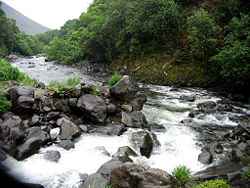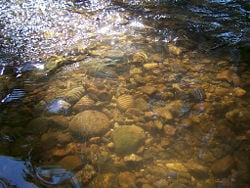Stream
A stream, brook, beck, burn, creek, crick, kill, rill, syke, bayou, rivulet, or run is a body of water with a current, confined within a bed and banks. The biological habitat in the immediate vicinity of a stream is called a riparian zone.
In the scientific community, stream is also an umbrella term for all types of flowing natural waters, regardless of size. The study of streams and waterways in general is known as surface hydrology and is a core part of environmental geography.
Streams are important as conduits in the water cycle, instruments in aquifer recharge, and corridors for fish and wildlife migration. By connecting fragmented habitats, they help conserve biodiversity.
Alternative names for a stream
In the United Kingdom, there are several regional names for a stream:
- Beck is used in Yorkshire, Lancashire and Cumbria.
- Bourne is used in the chalk downland of southern England
- Brook is used in the Midlands.
- Burn is used in Scotland and North East England.
- Stream is limited to Southern England.
- Syke is used in lowland Scotland and Cumbria.
In North America:
- Kill in New York, Pennsylvania, Delaware, and New Jersey comes from a Dutch language word, as in Peekskill (NY), Fishkill (NY), Broadkill (DE), Schuylkill (PA) and Fresh Kills.
- Run in Ohio, Maryland, or Virginia can be the name of a stream, as in Bull Run or Difficult Run.
- Branch, fork, or prong can refer to tributaries that share the same name as the main stream.
Types of streams
- River
- A large natural stream, which may be a waterway.
- Creek (North America and Australia)
- A small to medium sized natural stream. Sometimes navigable by motor craft and may be intermittent. In some dialects it is pronounced: "crick."
- Creek (UK and India)
- A tidal inlet, typically in a saltmarsh or mangrove swamp. Alternatively, flowing water between enclosed and drained, former saltmarshes or swamps. In these cases, the stream is the tidal stream, the course of the seawater through the creek channel at low and high tide.
- Tributary
- A contributory stream, or a stream that does not reach the sea but joins another river (a parent river). Sometimes also called a branch or fork.
- Brook
- A stream smaller than a creek, especially one that is fed by a spring or seep. It is usually small and easily forded. A brook is characterized by its shallowness and its bed being composed solely of rocks.
- Crick
- In some regions, it is equivalent to "creek"; in other regions, it may be smaller than a creek or deeper than a creek of the same width.
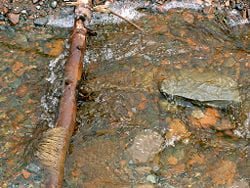
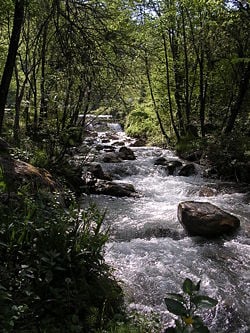
Parts of a stream
- Spring
- The point at which a stream emerges from an underground course through unconsolidated sediments or through caves. A stream can, especially with caves, flow above ground for part of its course, and underground for part of its course.
- Source
- The spring from which the stream originates, or other point of origin of a stream.
- Headwaters
- The part of a stream or river proximate to its source. The word is most commonly used in the plural where there is no single point source.
- Confluence
- The point at which the two streams merge. If the two tributaries are of approximately equal size, the confluence may be called a fork.
- Run
- A somewhat smoothly flowing segment of the stream.
- Pool
- A segment where the water is deeper and slower moving.
- Riffle
- A segment where the flow is shallower and more turbulent.
- Channel
- A depression created by constant erosion, that carries the stream's flow.
- Floodplain
- Flatlands on either side of the stream that are subject to seasonal flooding.
- Stream bed
- The bottom of a stream.
- Gauging station
- A point of demarkation along the route of a stream or river, used for reference marking or water monitoring.
- Thalweg
- The river's longitudinal section, or the line joining the deepest point in the channel at each stage from source to mouth.
- Wetted perimeter
- The line on which the stream's surface meets the channel walls.
- Nickpoint
- The point on a stream's profile where a sudden change in stream gradient occurs.
- Waterfall or cascade
- The fall of water where the stream goes over a sudden drop called a nickpoint; some nickpoints are formed by erosion when water flows over an especially resistant stratum, followed by one less so. The stream expends kinetic energy in "trying" to eliminate the nickpoint.
- Mouth
- The point at which the stream discharges, possibly via an estuary or delta, into a static body of water such as a lake or ocean.
Sources of stream water
Streams typically derive most of their water from precipitation in the form of rain and snow. Most of this water re-enters the atmosphere by evaporation from soil and water bodies, or by the evapotranspiration of plants. Some of the water proceeds to sink into the earth by infiltration and becomes groundwater, much of which eventually enters streams. Some precipitated water is temporarily locked up in snow fields and glaciers, to be released later by evaporation or melting. The rest of the water flows off the land as runoff, the proportion of which varies according to many factors, such as wind, humidity, vegetation, rock types, and relief. This runoff starts as a thin film called sheet wash, combined with a network of tiny rills, together constituting sheet runoff; when this water is concentrated in a channel, a stream has its birth.
Characteristics of streams
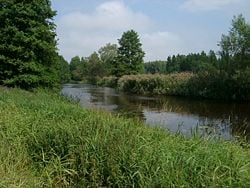
- Ranking
- Streams in geographic terms are awarded order designations. A stream of the first order is a blue-line stream which does not have any other blue-line stream feeding into it. A stream of the second order is one which is formed by the joining of two or more blue-line streams. A third-order stream is one below the confluence of two or more second-order streams; a fourth-order stream is formed by the confluence of at least two third-order streams, and so forth.
- Gradient
- The gradient of a stream is a critical factor in determining its character, and is entirely determined by its base level of erosion. The base level of erosion is the point at which the stream either enters the ocean, a lake or pond, or enters a stretch in which it has a much lower gradient, and may be specifically applied to any particular stretch of a stream.
- In geologic terms, the stream will erode down through its bed to achieve the base level of erosion throughout its course. If this base level is low, then the stream will rapidly cut through underlying strata and have a steep gradient, and if the base level is relatively high, then the stream will form a flood plain and meanders.
- Meander
- Meanders are looping changes of direction of a stream caused by the erosion and deposition of bank materials. These may be somewhat sine-wave in form. Typically, over time, the meanders don't disappear but gradually migrate downstream.
- If some resistant material slows or stops the downstream movement of a meander, a stream may erode through the neck between two legs of a meander to become temporarily straighter, leaving behind an arc-shaped body of water termed an oxbow lake or bayou. A flood may also result in a meander being cut through in this way.
- Profile
- Typically, streams are said to have a particular profile, beginning with steep gradients, no flood plain, and little shifting of channels, eventually evolving into streams with low gradients, wide flood plains, and extensive meanders. The initial stage is sometimes termed a "young" or "immature" stream, and the later state a "mature" or "old" stream. However, a stream may meander for some distance before falling into a "young" stream condition.
Intermittent and ephemeral streams
In the United States, an intermittent stream is one that only flows for part of the year and is marked on topographic maps with a line of blue dashes and dots. A wash or desert wash is normally a dry streambed in the deserts of the American Southwest which flows only after significant rainfall. Washes can fill up quickly during rains, and there may be a sudden torrent of water after a thunderstorm begins upstream, such as during monsoonal conditions. These flash floods often catch travelers by surprise. An intermittent stream can also be called an arroyo in Latin America, or a wadi in the Arabic-speaking world.
In Italy an intermittent stream is termed a torrent Template:In it. In full flood the stream may or may not be "torrential" in the dramatic sense of the word, but there will be one or more seasons in which the flow is reduced to a trickle or less. Typically torrents have Appenine rather than Alpine sources, and in the summer are fed by little precipitation and no melting snow. In this case the maximum discharge will be during the spring and autumn. However there are also glacial torrents with a different seasonal regime.
A blue-line stream is one which flows for most or all of the year and is marked on topographic maps with a solid blue line. In Australia, an intermittent stream is usually called a creek, and marked on topographic maps with a solid blue line.
Generally, streams that flow only during and immediately after precipitation are termed ephemeral. There is no clear demarkation between surface runoff and ephemeral stream.
Drainage basins
The entire basin drained by the stream is termed the drainage basin, also known in North America as a "watershed,"[1] and in British English as a "catchment."
A basin will typically be composed of smaller basins. For instance, the Continental Divide in North America divides the Atlantic Ocean basin from the Pacific Ocean basin, but the Atlantic Ocean basin may be first divided into the Atlantic Ocean drainage and the Gulf of Mexico drainage. This delineation within the United States is termed the Eastern Continental Divide. The Gulf of Mexico basin may be divided into Mississippi River basin and a number of smaller basins, such as the Tombigbee River basin.
The Mississippi River basin includes the Ohio River basin, which in turn includes the Kentucky River basin, and so forth.
See also
Notes
- â In British English, however, a watershed is the dividing line between drainage basins, in other words a water divide
ReferencesISBN links support NWE through referral fees
- Gordon, Nancy D., et al. 2004. Stream Hydrology: An Introduction for Ecologists. 2nd ed. Chichester, West Sussex, England: Wiley. ISBN 9780470843581.
- Hauer, F. Richard, and Gary Anthony Lamberti. 2007. Methods in Stream Ecology. 2nd ed. Amsterdam: Academic Press. ISBN 9780123329080.
- Leopold, Luna B. 1997. Water, Rivers, and Creeks. Sausalito, CA: University Science Books. ISBN 0935702989.
- Leopold, Luna B. 2006. A View of the River. Cambridge, MA: Harvard University Press. ISBN 9780674018457.
- Schumm, Stanley Alfred. 2003. The Fluvial System. Caldwell, NJ: Blackburn Press. ISBN 9781930665798.
Credits
New World Encyclopedia writers and editors rewrote and completed the Wikipedia article in accordance with New World Encyclopedia standards. This article abides by terms of the Creative Commons CC-by-sa 3.0 License (CC-by-sa), which may be used and disseminated with proper attribution. Credit is due under the terms of this license that can reference both the New World Encyclopedia contributors and the selfless volunteer contributors of the Wikimedia Foundation. To cite this article click here for a list of acceptable citing formats.The history of earlier contributions by wikipedians is accessible to researchers here:
The history of this article since it was imported to New World Encyclopedia:
Note: Some restrictions may apply to use of individual images which are separately licensed.



